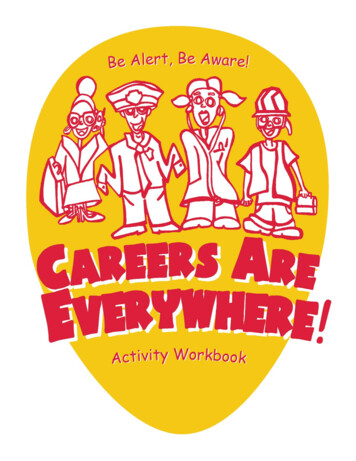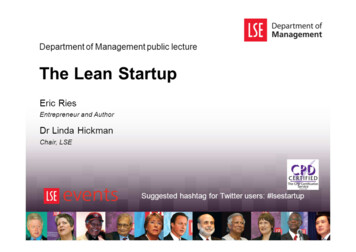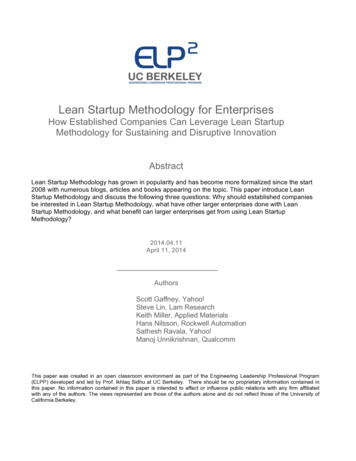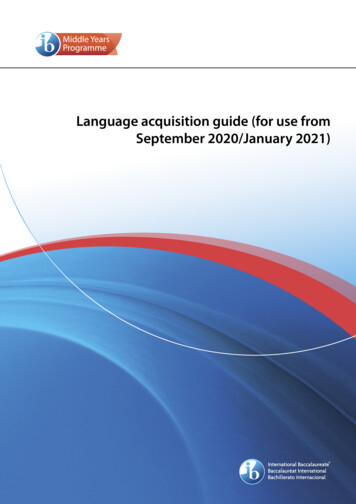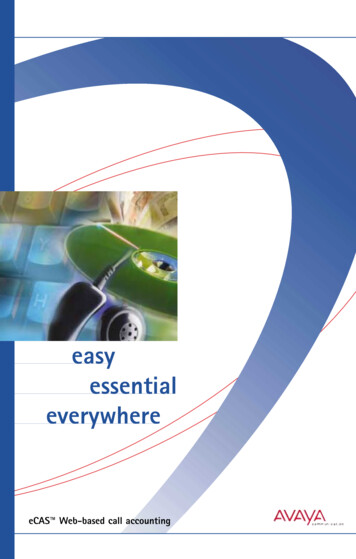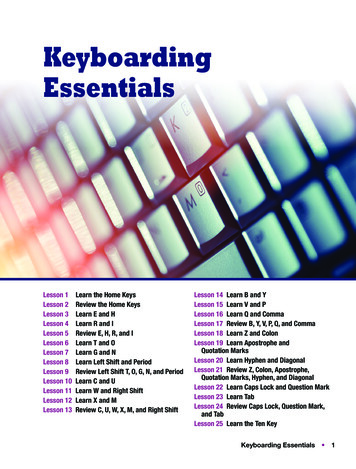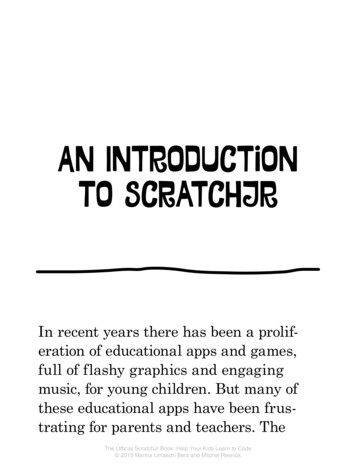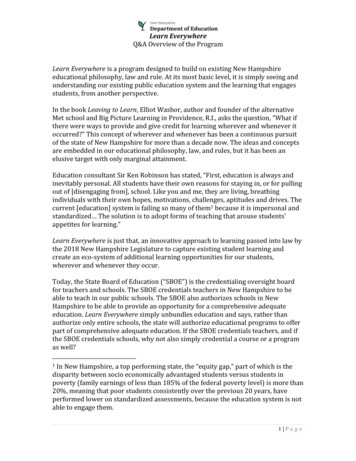
Transcription
Learn EverywhereQ&A Overview of the ProgramLearn Everywhere is a program designed to build on existing New Hampshireeducational philosophy, law and rule. At its most basic level, it is simply seeing andunderstanding our existing public education system and the learning that engagesstudents, from another perspective.In the book Leaving to Learn, Elliot Washor, author and founder of the alternativeMet school and Big Picture Learning in Providence, R.I., asks the question, “What ifthere were ways to provide and give credit for learning wherever and whenever itoccurred?” This concept of wherever and whenever has been a continuous pursuitof the state of New Hampshire for more than a decade now. The ideas and conceptsare embedded in our educational philosophy, law, and rules, but it has been anelusive target with only marginal attainment.Education consultant Sir Ken Robinson has stated, “First, education is always andinevitably personal. All students have their own reasons for staying in, or for pullingout of [disengaging from], school. Like you and me, they are living, breathingindividuals with their own hopes, motivations, challenges, aptitudes and drives. Thecurrent [education] system is failing so many of them1 because it is impersonal andstandardized The solution is to adopt forms of teaching that arouse students’appetites for learning.”Learn Everywhere is just that, an innovative approach to learning passed into law bythe 2018 New Hampshire Legislature to capture existing student learning andcreate an eco-system of additional learning opportunities for our students,wherever and whenever they occur.Today, the State Board of Education (“SBOE”) is the credentialing oversight boardfor teachers and schools. The SBOE credentials teachers in New Hampshire to beable to teach in our public schools. The SBOE also authorizes schools in NewHampshire to be able to provide an opportunity for a comprehensive adequateeducation. Learn Everywhere simply unbundles education and says, rather thanauthorize only entire schools, the state will authorize educational programs to offerpart of comprehensive adequate education. If the SBOE credentials teachers, and ifthe SBOE credentials schools, why not also simply credential a course or a programas well?In New Hampshire, a top performing state, the “equity gap,” part of which is thedisparity between socio economically advantaged students versus students inpoverty (family earnings of less than 185% of the federal poverty level) is more than20%, meaning that poor students consistently over the previous 20 years, haveperformed lower on standardized assessments, because the education system is notable to engage them.11 P age
Learn EverywhereQ&A Overview of the ProgramPractically, what does that mean and what does that look like?Learn Everywhere is built on a premise of win-win. It sees education as an expandinguniverse of opportunity that capitalizes on learning across the board.While for the most part, school takes place from 7:30am – 2:30pm inside a schoolbuilding for 180 days a year, students are learning outside of that time frame andoutside of that location. Some of this “outside the school” learning is formalized,such as after-school tutoring or dance lessons, and some is less formalized, such asan after-school job where a student is gaining valuable capacity across a number ofdomains. Learn Everywhere creates a vehicle to capture all students learning andgive students credit for it.Compared to a zero-sum game, in which the addition of this program takessomething away from our already strong public education system, Learn Everywhereexpands the educational opportunity universe without taking anything away.ExampleLet’s consider a student who loves performing arts and participates in a local Boysand Girls Club (“BGC”) performing arts program. Let’s also assume that the BGC hasenrolled its theater arts program as an approved Learn Everywhere program.This student now has the option to participate in the BGC theater arts program forhigh school credit. While they are participating in the BGC performing arts program,they can also participate in their public school performing arts program, if theywant (e.g., nothing is lost). However, if they find that practices at the BGC program,which are three nights a week until 9pm, do not give them enough time to dohomework, they could elect to take a study hall in their public school (all schoolshave study halls in all time blocks) to do their homework so they do not have to do itat night after play practice at the BGC. This student may also decide to take anelective course during that period.In addition to creating more educational options for the student, it can reduce thelevel of stress experienced by the student and family, stress representing anincreasing problem in our current culture.What is important to consider with this example is that with or without the LearnEverywhere option, the student is already participating in the BGC performing artsprogram. Learn Everywhere simply finds a way for that deep and engaging learningto count for academic credit.2 P age
Learn EverywhereQ&A Overview of the ProgramLet’s look at a few questions that one might have when considering this program forNew Hampshire. So how does the program work?o Applicants interested in offering education opportunities for studentswill complete an application with information about the program,including the course credit that will be offered (from education rule306, minimum standards), an outline of the program, how studentprogress will be monitored and how assessment and grading will becompleted.o The New Hampshire Department of Education (“NHDOE”) will reviewthe application for completeness. Once complete, applicants willappear before the SBOE and present their program for approval. TheSBOE will approve, conditionally approve or deny the application. Ifthe program meets the requirements, the SBOE will authorize theprovider a one-year license to operate.o During that period, the NHDOE will complete a monitoring visit of theprogram to determine that it is being implemented as presented tothe SBOE. If the NHDOE review is satisfactory, the SBOE will extend afive-year authorization to the program. After five years, the programwill be subject to renewal through the initial application process.o As students complete the program, they will be awarded a certificateof completion and a grade that they will present to their home districtfor credit, if the student desires credit.o Annually, the programs will report participation and credits awardedto the NHDOE for reporting to the SBOE.This Learn Everywhere process has been modeled after the current CharterSchool authorization program. How does the Learn Everywhere affect school funding? Is this an unfundedmandate?o Learn Everywhere does not affect school funding. Schools willcontinue to be funded under the current formulas. Learn Everywheredoes not require the school to create any new programs oradministrative supports. Students who complete a Learn Everywhereprogram will receive a certificate with a grade from the participatingprogram. This certificate will be provided to the student’s school bythe student so that credit can be awarded.o Keep in mind that Learn Everywhere is simply capturing the learningthat is already taking place through student participation in programsoutside of school. Learn Everywhere creates a pathway for students to3 P age
Learn EverywhereQ&A Overview of the Programapply that learning toward meeting the minimum standards forgraduation established by the SBOE. Shouldn’t we require teachers in these programs to be credentialed so that weknow the students are getting a good education?o The SBOE and New Hampshire public schools have a long-establishedpolicy that is reflected in both law and rule to accept educationalcredit from non-certified teachers. There is no requirement forteachers in either private or home education settings to be certified.Public Charter schools require that only 50% of teachers be certifiedor have at least 3-years of teaching experience. Every year, manystudents coming out of these education settings transfer to traditionalpublic school settings and higher-education pursuits, and the creditsthey bring with them are readily accepted.o Learn Everywhere captures the essence of state minimum educationstandards which state that we should “harness all availablecommunity resources.” (ED 306.04 (k) (6)) Learn Everywhere createsa framework to engage engineers to teach our students aboutengineering, math and physics, artists to engage them on the stageand in the studio, and entrepreneurs to open up the world of businessto them. As Clay Christensen writes in the forward of Julie Freeland’sbook Who You know: Unlocking Innovations that Expand studentNetworks, Learn Everywhere allows those not even part of ourtraditional education system to “mentor, support and inspire youngpeople.”o The assumption that a credentialed educator always results in abetter educational outcome is not born out by the underlying data.While that may be true in certain circumstances, the better measure ofstrong student outcomes is based on their level of engagement in theireducation. If they are engaged, they will perform better. Stateacademic assessment results show that only about 50% of students inthe traditional public school reach proficiency. These programs would be unfair. If the program charged tuition, not everystudent could afford to pay.o The SBOE has a long and established policy to permit families andstudents to access private educational options. Thousands of NewHampshire families pay tuition to private schools, affording thosestudents access to a private school option that is not universallyavailable to all New Hampshire students simply because of financiallimitations.o Many of the programs that might become available to studentsthrough this program are offered for free or at reduced rates. In many4 P age
Learn EverywhereQ&A Overview of the Programcases they are readily available to families without financial resourcesor are offered on a sliding scale based on capacity to pay. Thisincludes programming through organizations like Boys and GirlsClubs, Girls, Inc. and through many of our public school after-schoolprograms. Learn Everywhere has the ability to increase educationaloptions for disadvantaged students and families.o Many businesses, eager to source qualified employees for theirbusinesses, support excellent learning opportunities, without cost, forthose students who show an interest in a particular vocational field.Programs like Learn Everywhere will encourage the development ofmore of these work-based learning opportunities.o By unbundling these education options, a family that may not be ableto afford a full private education, may be able to afford part of thateducation in the form of a specific program, resulting in increasedaccess to education options for families. Won’t these programs limit opportunities for good teachers if students do someof their learning outside of the traditional school system?o Actually the opposite is true. Teachers interested in taking advantageof Learn Everywhere will have the ability to pursue teaching in itsmost pure form. A common refrain heard from teachers is frustrationat an overly regulated and burdensome system that causes them tospend more time administrating students than instructing them. Aninspired teacher may discover the entrepreneurial aspect of theprogram and can now set up their own learning program to instructstudents. These teachers may teach at a traditional public schoolduring the regular school day, but decide to add an independentprogram in the afternoon or on a weekend, to pursue teaching in aless restrictive form.o Many of the programs may seek out credentialed educators in aneffort to provide high quality programming and to differentiate theirinstruction, creating expanded employment opportunities foreducators. But what about accountability? How will we know that students are learningwhat they need to know?o Accountability and assessment are an important part of the programapplication process. Applicants will describe how they will assessstudents across the competencies that the student is expected toattain in the same way charter schools do now.o One of the really great aspects of Learn Everywhere is how seamlesslyit fits into and supports the existing public school system. Existing5 P age
Learn EverywhereQ&A Overview of the Programstate and federal accountability systems are all still in place. Studentsare still required to take state and federal accountability assessments. Doesn’t Learn Everywhere cross the line and interfere with local control ofeducation?o Learn Everywhere does not create a state level high school diploma.The issuance of a diploma is the domain of the local school district.The determination of credit requirements for graduation is aresponsibility of the local school board. The SBOE has authorized theminimum standards required for a high school diploma. LearnEverywhere is simply a program sanctioned by the SBOE for studentsto earn credits that count toward meeting those minimum standardsthat the SBOE has established leading to graduation. Local schoolboards will still be required to establish local graduationrequirements that meet or exceed the minimum standards. Won’t this program put students with disabilities at a disadvantage?o Like many other aspects of Learn Everywhere, supports for studentswith an Individual Education Plan (IEP) will follow the existingpractice. Presently, when services or special education programs arecalled out in an IEP to support a student’s learning, schools oftencontract with outside service providers. Authorized Learn Everywhereprograms will function in the exact same manner. When an IEP teamand parents believe that participation in a Learn Everywhere programis the right course of action for a student, and it is written into the IEP,Learn Everywhere program participants will coordinate with theschool to accommodate appropriate services in support of thestudent. The same approach would apply for students with 504 plans.o Every day, schools in New Hampshire contract with outside providersto help students with IEP’s in the areas of occupational therapy,physical therapy or speech therapy. Learn Everywhere simply expandsoptions for math therapy, language arts therapy, and physicaleducation therapy as well, when the IEP teams sees that as being inthe student’s best interest. How do we know students will be safe in these alternative programs?o This is a great and vitally important question. In working on thisprogram, one thing discovered is that many families today participatein local student enrichment programs with little or no knowledge ofbasic safety precautions of the program. For example, parents mayhave no knowledge of the background checks performed forinstructors. Or perhaps they know that background checks are notpart of the routine, but close involvement with the program allows6 P age
Learn EverywhereQ&A Overview of the Programthem to be comfortable with their student’s participation. LearnEverywhere has established two basic controls in this area. Background checks are required for instructional staff.Instructional staff are prohibited from serving if they haveviolated or are pending disposition for a RSA 189:13-a Vviolation. Programs must develop a background check policyand provide that to participating families. Facilities must meet federal and state health and safetyrequirements that apply if there were not an Learn Everywhereprogram. Won’t Administrators of schools oppose this, as they might perceive that theyare losing some control over education?o The facts are that this program will not diminish administratorcontrol. It will not affect their budgets. It will not affect the programsthat they now offer to students. All New Hampshire students will stillbe offered the same academic opportunities afforded to them now.o Rather than losing control, administrators will see that they aregaining a valuable tool to help meet the goal that we share, bringingall students to strong outcomes and bright futures. Perhaps more thananyone else in our state, administrators of schools know thecircumstances of students in our schools. They know how large andhow persistent the equity gap is. They know that there are certainstudents who the current system is simply unable to reach or connectwith. They often direct these students to alternative educationprograms to try to find ways to engage them in their education.Administrators will recognize that Learn Everywhere gives them yetanother tool to be able to help all students succeed. What if an emergency situation arises that requires the program to besuspended?o While the program authorization can only occur through the SBOEprocess, the NHDOE has authority to suspend a program’s license tooffer credit if they find that there is a public health, safety or welfareconcern. When such a suspension occurs, its ultimate resolution willfollow the RSA 541-A:30, III adjudicative process with appropriatedue process measures to the program operator.7 P age
Learn Everywhere Q&A Overview of the Program 1 P a g e Learn Everywhere is a program designed to build on existing New Hampshire educational philosophy, law and rule. At its most basic level, it is simply seeing and understanding our existing public education system and the
